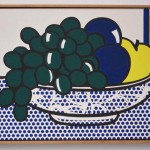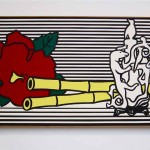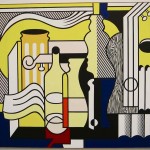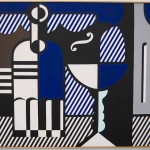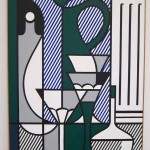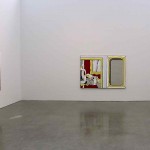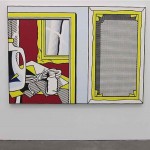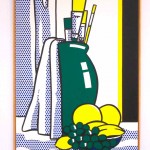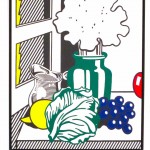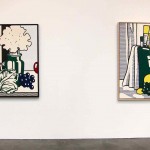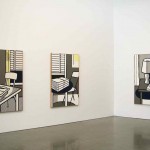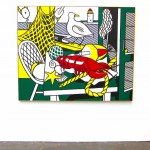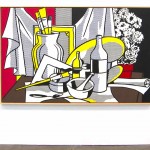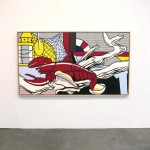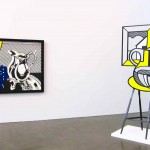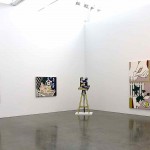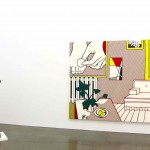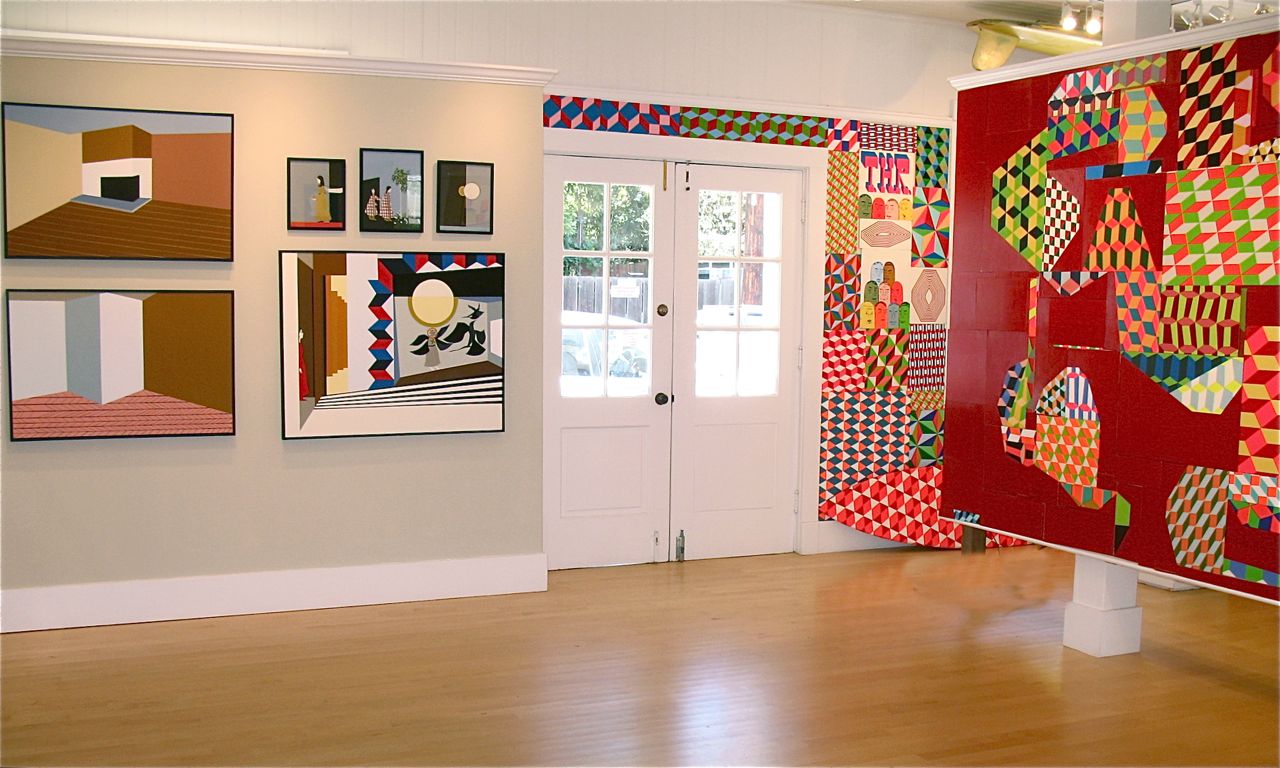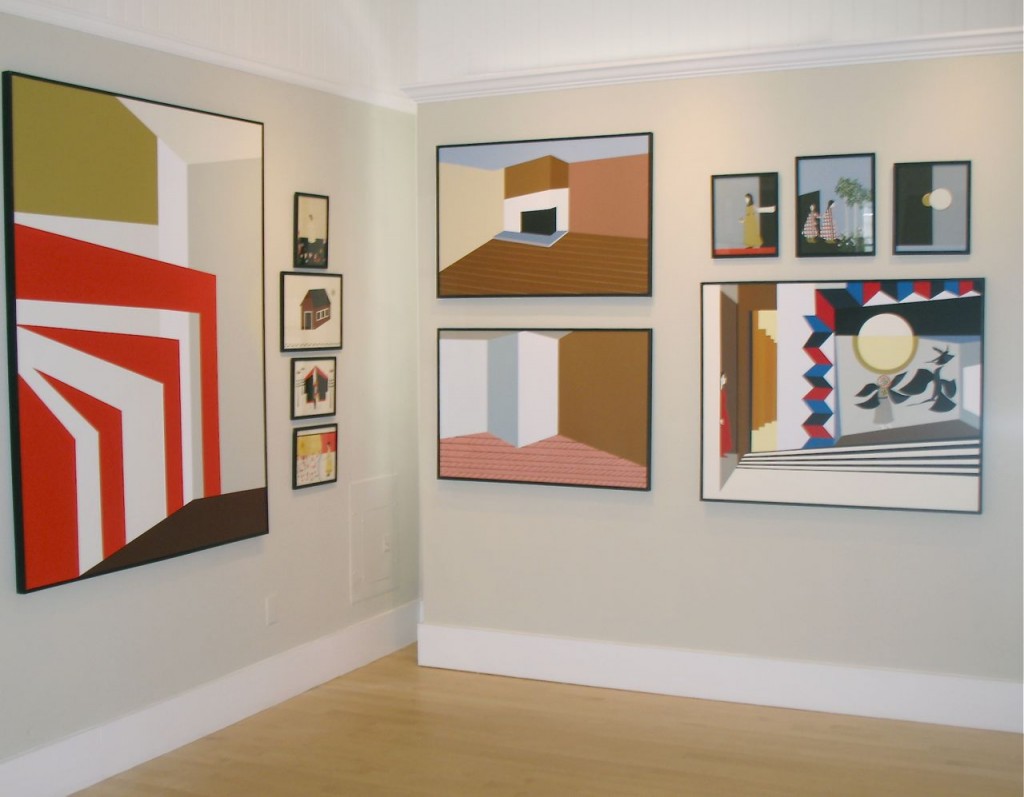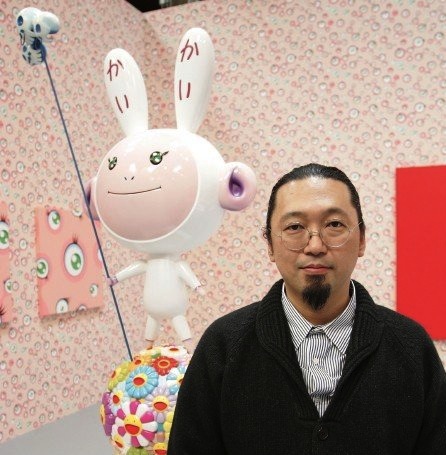Archive for the 'Uncategorized' Category
Tuesday, June 22nd, 2010
Pop Will Eat Itself :: Lichtenstein’s Still Lifes at Gagosian
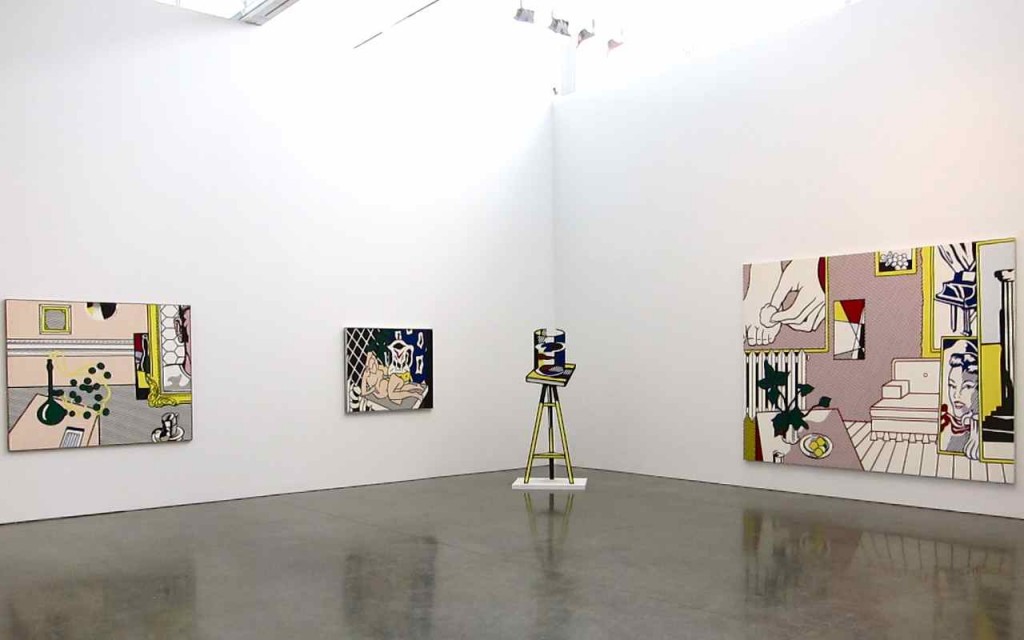
(All photos: Jeff Newman/TheArtCollectors)
Though Roy Lichtenstein is most remembered for his pioneering contributions to the early American pop movement of the 1960s, he continued to make new art up to the 1990s. From 1972 – 1986 he produced a large body of painting and sculpture that can be described as pop still-lifes. Technically, these were rendered in the same style of his popular comic-book based art, mimicking mechanical methods of production through the use of vivid primary colors, sharp lines, and his trademark simulation of the Ben-Day printing process. Thematically however, Lichtenstein’s subject matter veered away from mass culture and the recreation of commercial imagery. In place of D.C. comic panels we find the objects of traditional still life painting like fruits, vases or items arranged on tables.
Make the mistake of reading too carefully, and you might think there was some grand message here – that in the same way mass media has, the stuff of these works too has become part of our collective consumer conscience. However, like the rest of his art, Lichtenstein was quick to question any profound reading of this series, noting, “When we think of still lifes, we think of paintings that have a certain atmosphere or ambience. My still life paintings have none of those qualities, they just have pictures of certain things that are in a still life, like lemons and grapefruits and so forth.”
For a body of work whose deeper meaning even the artist was quick to denounce, this is truly a site to behold. In the first exhibition devoted entirely to this series, Gagosian Gallery’s presentation of some fifty still lifes is one that rises to museum standards and deserves to outlive its summer gallery viewing. That being said, reflecting on his art with John Coplans in 1972, Lichtenstein remarked, “I don’t think that whatever is meant by it is important to art.”
Roy Lichtenstein – Still Lifes
Gagosian Gallery
May 8 – July 30
555 West 24th Street
New York, NY 10011
212.741.1111
(All text and photos: Jeff Newman/TheArtCollectors)
Monday, June 21st, 2010
Amusing Ourselves To Death :: McGee + Rojas Together at Bolinas Museum
Barry McGee doesn’t watch TV. “These are all things that Americans do, they sit at home and watch television, they go into work the next day and everyone talks about what happened on Taxi—that’s one of the last shows I watched on television, sorry.”
Mcgee is known for overwhelming his audience with an inundation of mind numbing geometric clusters that visualize the psychological and social effects of media bombardment. Like the troubled characters found in them, looking at these works can leave the brain both exhausted and confused in a cognitive haze that Jerry Mander predicted would ultimatley lead to the expansion of power by dominant controllers in society.
Have we been manipulated, or are we to blame? As Neil Postman later distinguished, Orwell’s vision of the future and Huxley’s Brave New World were not one in the same. One warned that we will be overcome by externally imposed domination. The other prophesized something far more unsettling – that we will come to love our oppression, freely trading in our capacities to think for the technologies and entertainment we cherish.
Mander urged us to be radical – to “kill our televisions” and dismantle technological civilization. Postman warned it was getting too late – we had already willingly given up and “amused ourselves to death.” Lately, McGee seems caught in the middle. His chaotic wall static has been disrupted, yielding to dense blocks of solid red, with only broken, fragmented shards of pattern remaining. These have given way to simpler forms – a few small floating cubes, a single triangle or an octagon. There are even recognizable objects like detergent bottles – the ultimate sign of the never ending mindless consumer choices that have replaced actual freedom of thought. If the pessimism of his work from the last few years rendered us helplessly adrift in a violent media frenzy, these newer installations show McGee pushing back against the noise, urging us to break through the clutter, recognize our own complicity, and regain control.
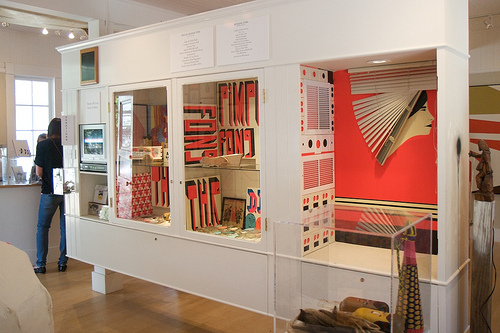
(Image: Gamma888)
Partner in life and art Clare Rojas explores similar new territory. The empty interiors of her recent paintings suggest spaces to be filled. Stripped of their belongings, we are pressed to find any identity in what remains in these barren rooms. In one painting a figure lays in bed staring at a TV on a nightstand. Another shows a simple house suspended against a white background. One sad looking woman sits at an empty table, while another reaches out her hand towards a garden of flowers. In an alcove, a woman’s face is partially covered by window blinds. In the same area, walls are cleverly paneled in central air vents and light switch or outlet covers that take on the look of morse code dots and dashes. But what does it all mean? While McGee reveals the brainwashing of our collective conscience, Rojas projects the effects of this dumbing down onto the trappings of domestic living, where we’ve cashed in our free will for freedom at the checkout line.
It is interesting that the Bolinas exhibition is being presented with two separate titles. While this isn’t the first time the artist couple has shown together, the two have joined here to deliver what is there most seamless presentation to date. When asked by fellow artist Andrew Jeffrey Wright where he’d like to be in five years, McGee said he “[hoped] to be entirely removed from society by that time. Off the map. Checked out.” With Leave it Alone we can understand why, and with Rojas’ Together at Last it’s clear that if the time comes, the two will disappear hand in hand.
Lots more images over on TAC member Gamma888’s flickr
Barry McGee – Leave it Alone / Clare Rojas – Together at Last
June 19 – August 1
Bolinas Museum
Hours: Fridays – Sundays, 1 – 5 pm
48 Wharf Road
Bolinas, CA 94924
phone: 415.868.0330
Friday, June 18th, 2010
Murakami to Exhibit in Qatar
Reporting from Art Basel, the Art Newspaper says dealer Emmanuel Perrotin has revealed that a Takashi Murakami exhibition in Qatar is in the works for 2012, and will be more substantial than the show set to open at the Palace of Versailles this coming September.
Though Perrotin promises the Qatar show to be “a new concept and much broader,” we wonder just how much further it will go. Both exhibits are partly funded by the Qatar Museums Authority, largely an extension of the nation’s royal family (who were among the VIP visitors to Art Basel this week along with QMA director Roger Mandle). Considering the mixed civil and Islamic law code of the Arab emirate, don’t be surprised with a fairly reserved display showcasing the tamer side of Murakami, perhaps heavier on his smiling flowers and DOB characters, with less of the questionable body fluids.
Murakami tours his 2008 exhibit at MOCA Los Angeles. (Video via MOCA LA)
Monday, June 14th, 2010
Inside Out :: Ernesto Neto’s Largest Installation Opens in London
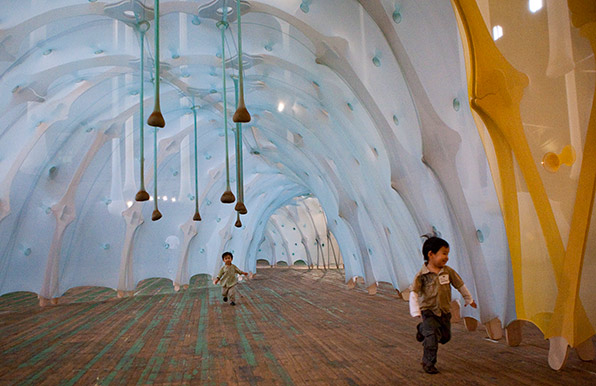
Ernesto Neto – anthropodino, 2009, commissioned for the Park Avenue Armory, New York, 2009 (Image: James Ewing via)
In what is being billed as his most ambitious exhibition to date, Brazilian sculpture artist Ernesto Neto will open a new site specific, all-encompasing environment at London’s Southbank Centre Hayward Gallery this Saturday, June 19. Viewers will act as participants, exploring a sequence of connected spaces that merge sculpture and architecture, at times recalling biological systems. For this new exhibition, Neto will create his first outdoor installations, including a sculptural pool that visitors will be allowed to enter.
Neto’s installation is part of The New Décor, an international survey of some 30 contemporary artists whose whose work explores interior design as a means of engaging with changes in contemporary culture.
Ernesto Neto – The Edges of the World / The New Decor
July 19 – September 5
The Hayward Gallery at Southbank Centre
Belvedere Road, London SE1 8XX
Wednesday, June 9th, 2010
Thing Quarterly Collaborates with Chris Johanson + James Franco
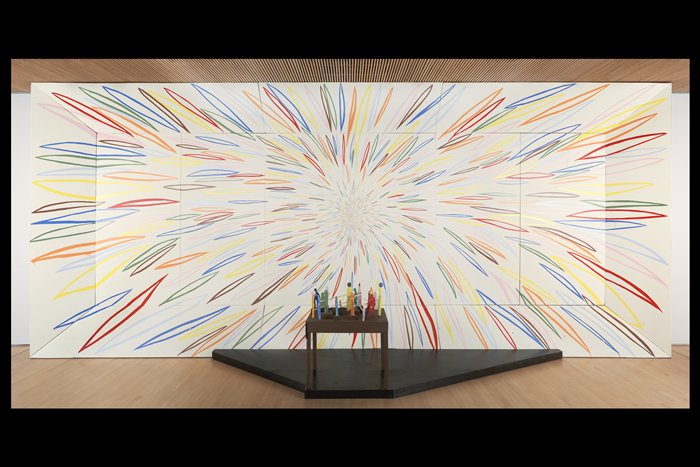
Chris Johanson (Image via The Thing)
THE THING is gearing up to release the first installment of their new subscription cycle. Each year, the quarterly “periodical” collaborates with four artists to create limited art objects that each incorporates text. Issues 11-14 kick off with Chris Johanson, followed by fashion design team Doo.ri, artist Matthew Higgs, and will wrap up with actor/artist James Franco, who has shifted his recent focus to intellectual and artistic endeavors outside of acting.
To celebrate the launch of issue 11, Chris Johanson will host an event June 17 at SFMOMA, including video and musical performances. The event is free to Thing subscribers, or with museum admission. We’re not sure what Johanson has come up with for his issue yet, but have been promised that “guests can purchase Johanson’s…issue and put it to use while watching video projections of moonrises…”
Get your one year subscriptions here
Wednesday, June 9th, 2010
New Record set for Walton Ford

Walton Ford’s Lisbon Rhinoceros, 2008 set a record for the artist at auction last month. (Image via Phillips de Pury)
As Marion Maneker has suggested, recent events indicate Walton Ford is fast on the rise, with his works crossing into blue-chip status. Last month Ford shook the auction market when Loss of the Lisbon Rhinoceros (estimated at $550-750,000) sold for $1,022,500 at Phillips Halsey Minor Collection auction, setting a new record for his work. The next day, Fords’ 2006 work La Fontaine, (also from Minor’s collection) took top-lot at Phillips Part II Contemporary Art sale when it sold for $746,500, far out-performing its original $250-350,000 estimate. Early this year, Wal-mart heriess’ Alice Walton’s Crystal Bridges Museum announced it had acquired Fords’ 11ft x 8.5 ft triptych, The Island, which first appeared as the centerpiece of his Oct. 09′ show at Paul Kasmin.
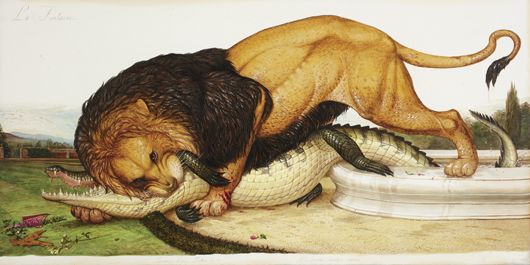
Walton Ford – La Fontaine, 2006. (Image via Phillips de Pury)
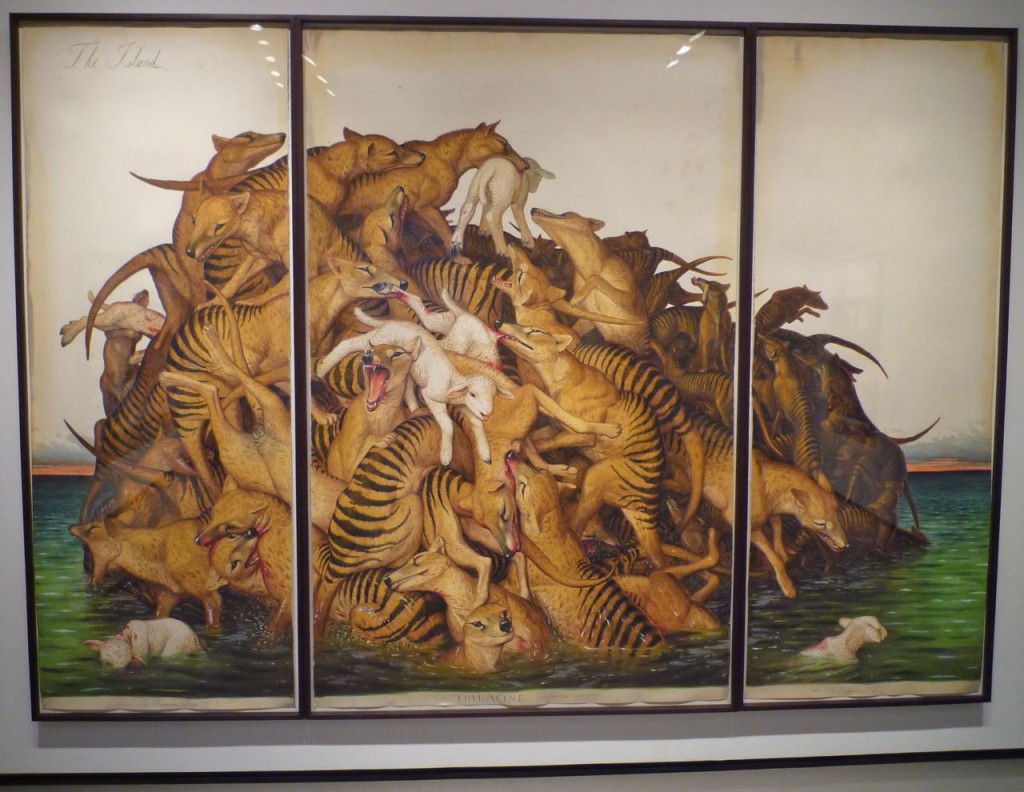
Walton Ford – The Island, 2009. (Image: Jeff Newman/TheArtCollectors)
Wednesday, June 9th, 2010
Historic Haring Mural in Need of Rescue
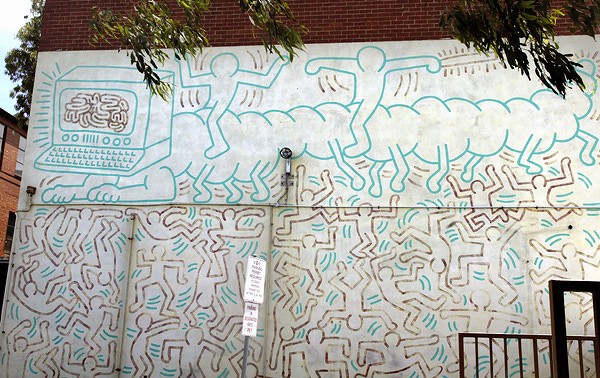
The faded and damaged Haring mural as it looks today. (Image: Andrew De La Rue via Sydney Morning Herald)
The Art Newspaper reports that the last surviving mural Keith Haring painted entirely on his own, and the first project he completed with the assistance of a cherry picker, is in dire need of preservation. Painted in 1984 during Haring’s only visit to Australia, the mural occupies the wall of the former Collingwood Technical College in a Melbourne suburb. Last restored in 1996, the significant work has not been maintained for almost 15 years, and suffers from significant surface lifting and cracking of the paint. Estimates to stabilize the outdoor work are reported at A$25,000 ($22,000 US), with an additional A$1,000 ($900) for annual upkeep.
Several major Australian arts institutions and local municipalities have banned together to raise support for its restoration. “It is our own government who has lapsed in its duty of care,” said one spokesperson, noting that the building is owned by the Victorian State Government and that the mural sits on its heritage registry.
”Yarra’s mayor Jane Garrett said, “The mural is a part of Yarra and inner-Melbourne’s cultural and physical landscape—and we want to ensure it stays that way,” adding that interested parties were in the process of setting up a working group including representatives from the arts community and other interested parties to “discuss the mural’s future and come to a consensus on the most appropriate way to preserve it.”
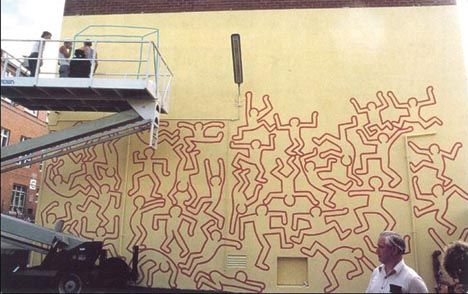
The original mural in progress durning Haring’s 1984 visit to Melbourne (Image via The Art Newspaper)
In more productive news, a new series of Keith Haring adhesive wall graphics (pictured below) has been released by Bilk, with several different designs available from $18 – $55.
Wednesday, June 9th, 2010
MoMA Lights
Tuesday, June 8th, 2010
Amidst Controversy, Brandeis Weighs Renting Rose Collection
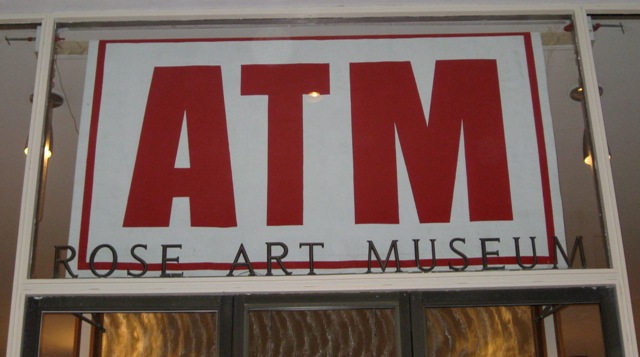
A sign erected by protesters on the night of a public hearing at the Rose Art Museum in February of last year. (Sarah Ewick via Bostonist)
Nearly a year and a half after Brandeis came under attack for voting to shore up university funds by closing down and selling off the Rose’s collection, the future of the museum still remains in question. After flip-flopping under pressure on its initial decision, Brandeis’ board is now considering renting out works from the Rose to generate income for the university.
In a press release dated May 28 and first reported by the Boston Globe, Brandeis announced that it was taking steps to “explore a range of alternatives to the sale of art from the Rose Art Museum in an effort to generate value from a portion of the collection while still maintaining ownership of the artwork.” More specifically, University President, Jehuda Reinharz, revealed that Brandeis was already “in discussions with Sotheby’s to solicit advice on non-sale partnerships, lending agreements and other creative solutions in the fundraising arena.”
To be clear, “lending” is less than upfront terminology to describe the potential plan. Simply put, Brandeis may be close to renting out portions of the 7,000+ piece Rose collection for profit.
Though the recent announcement makes sure to clarify that “Brandeis is committed to using a portion of any proceeds it realizes from art in the Rose Art Museum to directly benefit both the museum and the university’s Department of Fine Arts,” this really seems like lip service. It is abundantly clear that the universities’ motivation remains unchanged – to offset the economic troubles of Brandeis (not the Rose) by leveraging its control over the Rose’s collection as a cash-asset. No one who has been following these developments since last January has any doubt where the majority of any such revenue would end up – with the financially burdened university, and not with the Rose.
Furhtermore, while the university emphasizes that it would “Ideally…continue to own the art but find an innovative way to get value from it,” and that they have “not sold any art since that vote, and will not do so while it examines non-sale alternatives,” no guarantees have been given. In fact, Brandies has already cut a deal with Christies to put works on the auction block, if it ultimately decides to permanently shutter the Rose and deassess the collection.
Lee Rosenbaum (who has been diligently shedding light on the story since its beginning) makes some insightful new suggestions over on CultureGrrl – that preference should be given to Boston-area museums or educational institutions, that under no circumstances should Rose works be lent for private use by collectors or corporations, and that the core collection of important works from the collection should remain on campus, with the right to borrow back works from renters for educational or exhibition purposes.
For those who haven’t been following, the battle over the Rose began in January of last year, after Brandeis’ trustees announced it would close the museum and sell off its $350 million collection to insulate an increasingly threatened university endowment (see our previous reports here and here) which was hit hard by the global recession and Madoff scheme. With the support of every major museum association, The Rose’s board fired back on the grounds that the museum was not a university asset and such action would be in violation of the intentions of the museum’s founders, donors and established ethical codes. Controversy escalated further in July when museum overseers filed a lawsuit (read the full transcript here) to halt Brandeis from moving forward with its plans. While Brandeis has held off selling any art or closing the museum, they did fire the majority of the Rose’s staff, including the museum’s director, who has been outspoken against the university’s actions.
The proposed rental plan is certainly less egregious than the initial move to close the museum and toss its important public collection to the highest bidder. Moving forward, if Brandeis were willing to adhere to some ethical guidelines, like those proposed by Rosenbaum, at least it would allow for the Rose to remain a vital and active public institution, and carry out its original mission, as envisioned by its founders and early benefactors when it opened its doors in 1961.
Sunday, June 6th, 2010
Out of the Blue, Into the Air :: Yves Klein Retrospective at Hirshhorn

Yves Klein, Le Saut dans le vide [Leap into the Void], at 5, rue Gentil-Bernard, Fontenay-aux-Roses, France, October 1960. © 2010 Artists Rights Society(ARS), New York/ADAGP, Paris. Photo by Shunk-Kender, © Roy Lichtenstein Foundation. Courtesy Yves Klein Archives.
It is astounding that there hasn’t been a significant showing of Yves Klein in the U.S. for nearly three decades – almost as many years long as the artist’s short life. The fatal heart attack suffered by the 34 year old in 1962 signaled the end of a creative career that came and went in under a decade. Still, with little reference to anything that had come before, Klein’s contributions helped inform the transition from modern art’s focus on the tangible, to contemporary conceptual concerns with the theoretical.
The Hirshhorn Museum’s (Washington D.C.) current retrospective is a appropriate homage to such an important figure. Yves Klein: With the Void, Full Powers, includes major examples from every aspect of the artist’s career, including his Anthropometries, Cosmogonies, fire paintings, planetary reliefs, blue monochromes, sponge reliefs, “air architecture,” and immaterial works.
As crucial as his physical forms, are the ideas Klein communicated through bold and and acutely self-aware manifestos, personal notes, letters and interviews. Here, the museum has resurrected the artist-philosopher, allowing Kelin to share his own story and and ideas through a spirited and dynamic timeline that effectively aggregates multiple online social and media platforms. “We felt it was essential not only to present Klein as the maker of beautiful objects but also as a thinker, a philosopher who paved the way for future generations,” says exhibition co-curator Kerry Brougher, chief curator and deputy director of the Museum.
Selection from Yves Klein: The Blue Revolution. Director: François Lévy-Kuentz. Courtesy Yves Klein Archives. Coproduction © 2006 MK2TV, Le Centre Pompidou, Y Amu Klein/Moquay in association with France 5. Video © 2007 Le Réunion des musées nationaux—EDV 288
Visit the Hirshhorn now until September 12, and access the museum’s social media archive and interactive timeline here
Also essential are the online Yves Klein Archives and Pompidou’s archive of their 2007 exhibition.
Read on for more images Read the rest of this entry »
